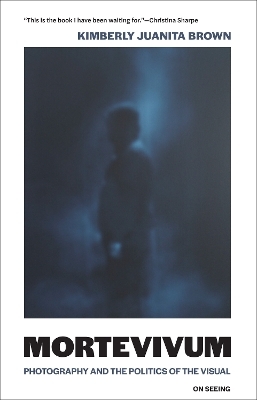
Mortevivum
Photography and the Politics of the Visual
Seiten
2024
MIT Press (Verlag)
978-0-262-54764-2 (ISBN)
MIT Press (Verlag)
978-0-262-54764-2 (ISBN)
A powerful examination of the unsettling history of photography and its fraught relationship to global antiblackness.
Since photography’s invention, black life has been presented as fraught, short, agonizingly filled with violence, and indifferent to intervention: living death—mortevivum—in a series of still frames that refuse a complex humanity. In Mortevivum, Kimberly Juanita Brown shows us how the visual logic of documentary photography and the cultural legacy of empire have come together to produce the understanding that blackness and suffering—and death—are inextricable. Brown traces this idea from the earliest images of the enslaved to the latest newspaper photographs of black bodies, from the United States and South Africa to Haiti and Rwanda, documenting the enduring, pernicious connection between photography and a global history of antiblackness.
Photography's history, inextricably linked to colonialism and white supremacy, is a catalog of othering, surveillance, and the violence of objectification. In the genocide in Rwanda, for instance, photographs after the fact tell viewers that blackness comes with a corresponding violence that no human intervention can abate. In Haiti, the first black republic in the Western Hemisphere, photographic “evidence” of its sovereign failure suggests that the formerly enslaved cannot overthrow their masters and survive to tell the tale. And in South Africa and the United States, a loop of racial violence reminds black subjects of their lower-class status mandated via the state. Illustrating the global nature of antiblackness that pervades photographic archives of the present and the past, Mortevivum reveals how we live in a repetition of imagery signaling who lives and who dies on a gelatin silver print—on a page in a book, on the cover of newspaper, and in the memory of millions.
The URL for this publication is https://on-seeing-mortevivum.org/.
Since photography’s invention, black life has been presented as fraught, short, agonizingly filled with violence, and indifferent to intervention: living death—mortevivum—in a series of still frames that refuse a complex humanity. In Mortevivum, Kimberly Juanita Brown shows us how the visual logic of documentary photography and the cultural legacy of empire have come together to produce the understanding that blackness and suffering—and death—are inextricable. Brown traces this idea from the earliest images of the enslaved to the latest newspaper photographs of black bodies, from the United States and South Africa to Haiti and Rwanda, documenting the enduring, pernicious connection between photography and a global history of antiblackness.
Photography's history, inextricably linked to colonialism and white supremacy, is a catalog of othering, surveillance, and the violence of objectification. In the genocide in Rwanda, for instance, photographs after the fact tell viewers that blackness comes with a corresponding violence that no human intervention can abate. In Haiti, the first black republic in the Western Hemisphere, photographic “evidence” of its sovereign failure suggests that the formerly enslaved cannot overthrow their masters and survive to tell the tale. And in South Africa and the United States, a loop of racial violence reminds black subjects of their lower-class status mandated via the state. Illustrating the global nature of antiblackness that pervades photographic archives of the present and the past, Mortevivum reveals how we live in a repetition of imagery signaling who lives and who dies on a gelatin silver print—on a page in a book, on the cover of newspaper, and in the memory of millions.
The URL for this publication is https://on-seeing-mortevivum.org/.
Kimberly Juanita Brown is the inaugural director of the Institute for Black Intellectual and Cultural Life at Dartmouth College where she is also an Associate Professor of English and creative writing. She is the author of The Repeating Body: Slavery's Visual Resonance in the Contemporary.
CONTENTS
SERIES FOREWORD IX
INTRODUCTION: THE MAKING OF PHOTOGRAPHIC BLACKNESS XI
1 THE EMPIRE 1
2 THE VIEWER 47
3 THE SENTIMENT 73
CONCLUSION: WE, STILL 103
ACKNOWLEDGMENTS 117
NOTES 123
INDEX 139
| Erscheinungsdatum | 01.02.2024 |
|---|---|
| Zusatzinfo | 40 BLACK AND WHITE ILLUS. |
| Sprache | englisch |
| Maße | 127 x 203 mm |
| Themenwelt | Kunst / Musik / Theater ► Fotokunst |
| Sozialwissenschaften ► Ethnologie | |
| Sozialwissenschaften ► Soziologie | |
| ISBN-10 | 0-262-54764-3 / 0262547643 |
| ISBN-13 | 978-0-262-54764-2 / 9780262547642 |
| Zustand | Neuware |
| Haben Sie eine Frage zum Produkt? |
Mehr entdecken
aus dem Bereich
aus dem Bereich
Fotos aus den 1980er Jahren von Mahmoud Dabdoub
Buch | Hardcover (2024)
Passage-Verlag
CHF 36,90
Buch | Hardcover (2024)
Spector Books OHG (Verlag)
CHF 58,75
der architektonische Blick : the architectural eye
Buch | Hardcover (2024)
König, Walther (Verlag)
CHF 53,20


